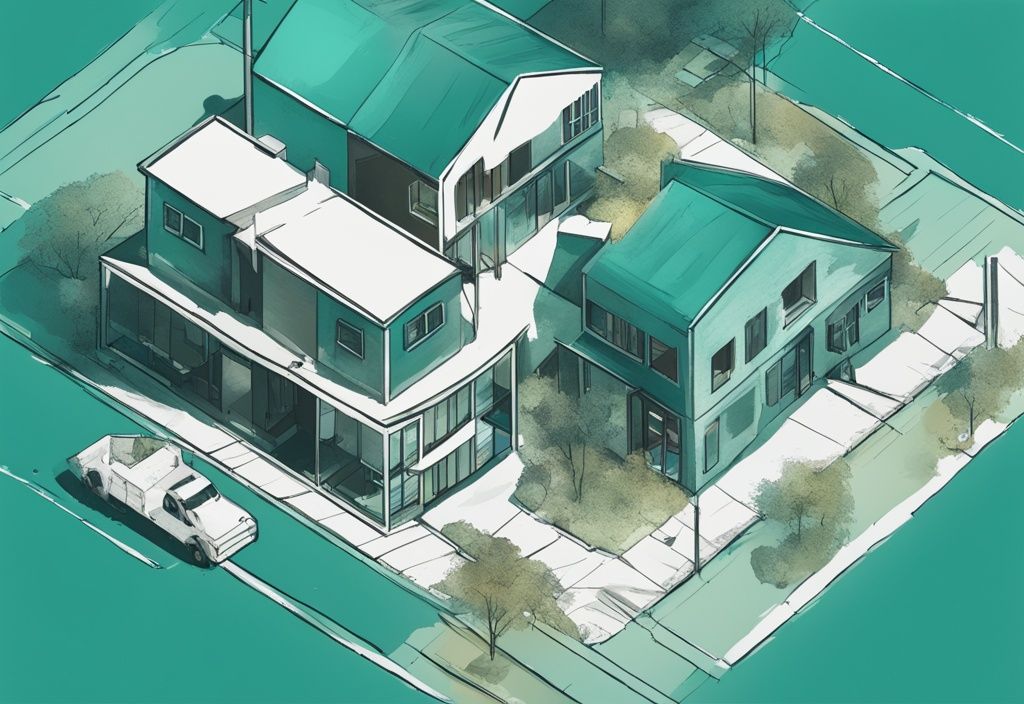Ever wonder how a change in the natural landscape could impact your property value? Let’s talk about accretion in real estate – a gradual, and sometimes surprising, increase in landmass that’s caused by sediment deposits along water bodies. This natural phenomenon can make a serious splash in property ownership rights, legalities, and of course, value.
In this guide, we’ll unravel the complexity of accretion and navigate its nitty-gritty. From understanding how it shapes property boundaries to its effect on real estate value – we’ll cover it all.
If you’re keen to make savvy land ownership decisions, understanding the role of accretion is vital. So sit back, and let’s embark on this journey of discovery together, helping you become a real estate expert in your own right.
Decoding the Concept of Accretion
In this section, we’ll dive into what accretion means in the context of real estate, how it occurs, and the differences between natural and human-induced accretion. By the end, you’ll have a clear picture of this fascinating phenomenon and its impact on property boundaries and value.
Definition of Accretion
Accretion in real estate is the gradual increase of landmass due to the accumulation of soil, sand, or rocks, usually influenced by water bodies like rivers, lakes, or oceans. If your property borders one of these water sources, accretion becomes especially significant. Imagine the soil being gently added over time—it’s the opposite of erosion, where the land wears away due to natural forces such as water, wind, and ice, reducing the overall size of your property.
The Process of Accretion
Accretion takes its time, unfolding over extended periods. Picture water flowing, carrying sediments that settle and add to the land bit by bit. This slow, steady process increases land size gradually, affecting property boundaries and often raising property value. However, this unpredictable process makes it hard to forecast the exact changes in a property’s size or value.
Natural vs Human-Induced Accretion
Accretion can be either natural or driven by human intervention. Natural accretion happens due to the continual buildup of sediments from natural water movements. Think of it as nature’s way of sculpting the land. On the other hand, human-induced accretion comes from activities like dredging or constructing breakwaters. These efforts manipulate water flow and sediment deposition, potentially raising complex ownership issues when property boundaries shift. Even activities like building dams or implementing flood controls can indirectly alter the rate and pattern of accretion, further complicating property management and ownership. It’s a fascinating yet intricate aspect of real estate that requires a keen understanding to navigate effectively.
Different Types of Accretion
Accretion in real estate refers to the gradual addition of land over time, typically along water bodies. This phenomenon can significantly impact property boundaries and ownership rights, so understanding its various forms is crucial for anyone involved in real estate.
Decoding Alluvion
Alluvion is a natural process where sediment like soil, sand, and organic material accumulates slowly along riverbanks, lakebeds, and coastlines. Imagine owning property by a river that gradually builds up more and more land over the years—pretty fascinating, right? This accumulation can actually redefine your property’s boundaries. What is accretion in real estate comes to life when considering how alluvion’s gradual build-up of land impacts property ownership and land area.
Artificial Accretion
On the flip side, artificial accretion results from human activities like dredging waterways or constructing breakwaters. These actions can produce new land, but it’s not as straightforward as it sounds. The human element introduces regulatory hurdles and potential legal disputes. Successfully navigating these complexities can be a real challenge. Understanding what is accretion in real estate demystifies how these man-made changes affect property rights and valuations.
Understanding Reliction
Reliction happens when water bodies recede, unveiling land that was once underwater. This is often a pleasant surprise for property owners near the water, as it increases their land area and potentially boosts property value. Like accretion, this newly exposed land integrates into the adjacent estate. Therefore, grasping what is accretion in real estate equips you with the knowledge to recognize the monetary benefits of reliction.

Contrasting Accretion: Avulsion vs Erosion
Not all changes in land are gradual additions like accretion. Avulsion and erosion often take land away. Avulsion is a sudden event such as a flood or earthquake that causes an immediate and noticeable change in property boundaries. On the other hand, erosion is a slow, gradual wearing away of land due to natural forces like water, wind, and ice. Both processes affect property rights and values, but in ways contrasting to accretion. Fully grasping what is accretion in real estate means also considering these opposing forces and their implications on your property.
Real Estate Implications of Accretion: Size, Value, and Rights
Does Accretion Change Property Size?
Accretion is a slow but steady process where landmass increases thanks to sediment deposits from water bodies. Picture this: tiny grains of sediment gradually accumulate, expanding your property piece by piece. Over time, this means your property boundaries shift, and guess what? Those boundaries need to be reevaluated to reflect the new layout. This isn’t just a technicality—your ownership rights will need to be updated, too. So imagine an ever-expanding backyard, but with some extra paperwork to keep everything squared away.
Accretion’s Influence on Property Value
Think of accretion as a natural gift that can bump up your property value. More land can often mean more value. However, since accretion is a slow process, predicting its exact impact on property value can be tricky. And here’s a head-scratcher: while insurance policies are quick to cover loss from erosion, they often don’t acknowledge the gradual land gain through accretion. This gap can complicate financial considerations when you’re assessing the true value of your property or calculating insurance premiums. It’s like finding extra money but not knowing if the bank will recognize it.
The Connection between Accretion and Riparian Rights
Let’s talk riparian rights—those rights you have as a property owner to access and use an adjacent water body. Accretion can change the game here. As more land piles up, your riparian rights might expand too. This means better access to the water and perhaps new usage opportunities. Imagine adding a new fishing spot or even a boat launch area to your property. If you’re considering developing your land further, it might be helpful to understand what a subdivision in real estate entails. But, be cautious! This slow land gain can also spark disputes with neighbors about where your water access starts and theirs ends. Think of it like slowly moving a fence but needing to renegotiate where the fence belongs.
Legal Aspects of Accretion
Delving into the legal dimensions of land accretion can help property owners understand their rights and navigate potential conflicts. Here, we explore essential considerations such as ownership of accreted land, local laws, and solutions for resolving disputes.
Who Owns Accreted Land?
Grasping the ownership dynamics of accreted land is key, particularly for properties next to water bodies where land can gradually expand, as understanding your ownership rights is essential for effective property management. You can learn more about these rights in detail [here](https://www.nycbar.org/get-legal-help/article/real-property-law/ownership-rights-in-real-property/). Typically, the owner of the adjacent property becomes the owner of the newly formed land. This means, as soil, sand, or rocks build up and extend the landmass, these additions become part of the existing property.
However, things can get tricky if the new land results from soil or sediment from an upstream property. In such situations, the upstream property owner doesn’t gain rights to the newly formed land. These scenarios often lead to legal disputes over changing property boundaries, stressing the importance of staying updated on local regulations and legal precedents concerning accretion.
Local Laws Governing Accretion
Accretion laws vary significantly by location, affecting how property rights and boundaries are established. Both local and federal regulations, especially in the U.S., play critical roles in shaping these frameworks. The details of these laws dictate how accreted land is governed, determining ownership rights and methods for dispute resolution.

Local authorities often impose rules on using and developing accreted land. Such regulations can impact property values and transactions, requiring property owners and investors to carefully navigate the legal landscape to make informed real estate decisions.
Resolving Accretion Disputes
Disputes over accreted land are quite common, especially when the new land holds high value due to its prime location or valuable resources. These conflicts usually revolve around property boundaries and who rightfully owns the new land, necessitating thorough documentation and expert help.
If the accreted land encroaches on existing rights of way, the property owner might not have additional claims beyond their original property limits. Regular land surveys and maintaining precise records can help track boundary changes due to accretion, minimizing disputes.
Landowners often need the assistance of land surveyors and legal experts to handle uncertainties about property boundaries following accretion. These professionals provide clarity and legal backing, ensuring property boundaries are accurately marked and respected, thereby protecting ownership rights and facilitating smoother real estate transactions.
Accretion’s Role in Real Estate Transactions
Accretion, the gradual addition of land due to natural forces, can significantly impact real estate transactions, especially for properties near water bodies. Understanding accretion’s effects and navigating its complexities is crucial for maintaining property value and avoiding legal disputes.
Strategies for Navigating Accretion Issues
- Real estate agents dealing with waterfront properties should be well-versed in what is accretion in real estate. Knowing this helps them predict changes in property size and value, ensuring they provide accurate assessments. Imagine a serene lakeside plot slowly expanding over the years – it’s essential to factor in such growth when buying or selling.
- Maintaining property value and ownership rights is another cornerstone of handling accretion. By understanding its impact on boundaries, agents can guide their clients through transactions smoothly, preventing disputes. Think of it like setting clear rules before a friendly neighborhood game – everyone knows their space, avoiding any potential arguments.
- For those looking to sell a property that’s grown due to accretion, conducting a land survey and consulting legal experts is crucial. Accurately defining land limits ensures all parties are on the same page regarding property size and boundaries. It’s akin to marking your campsite clearly before setting up – everyone needs to know where the lines are drawn.
- Developers and investors often seek lands with accretion potential, eyeing long-term gains. Spotting areas likely to experience accretion can lead to profitable investments as the land mass increases over time. Imagine planting a tree and watching it grow over the years – strategic locations can yield substantial rewards.

Conclusion
Final Insights on Accretion in Real Estate
Accretion is a fascinating but complex concept in real estate, defined as the gradual increase of land due to natural processes like sediment deposit from water bodies. This natural buildup can significantly impact property ownership, valuation, and legal aspects. It’s essential to understand what is accretion in real estate for making informed decisions, especially if your property is near water.
Top Takeaways
Think of accretion as nature giving your property a little extra gift of land over time. But with this gift comes the responsibility of keeping detailed records and adhering to local laws to manage shifting property boundaries.
Here’s why understanding accretion is crucial:
- Valuation: Your property’s value can rise as land mass increases.
- Ownership: With changes in boundaries, it’s important to stay updated on property rights.
- Legal Complexity: As accretion is slow and unpredictable, it brings complex legal questions. Always consult with legal experts to navigate these challenges effectively.
Gaining a solid grasp on what is accretion in real estate can really aid you in making savvy investment choices. To capture the evolving landscape effectively, consider investing in the best camera for real estate photography.
Properties affected by accretion can be quite lucrative, but they also come with their fair share of challenges. So, keep an eye on those property lines and don’t hesitate to reach out to a legal expert when needed.
FAQ
What exactly is accretion in real estate?
- Accretion in real estate refers to the gradual increase of your land through deposits of soil, sand, or rocks. Imagine a river slowly draping new layers of soil onto your riverbank property, bit by bit, extending it naturally. These deposits are usually brought by bodies of water like rivers, lakes, or oceans over time.
How is accretion different from erosion in real estate context?
- Think of accretion as nature’s way of gifting you more land. It’s the opposite of erosion, where the land gradually gets worn away by forces like water, wind, and ice. So, while accretion is about gaining ground through sediment deposits, erosion is about losing land as it’s slowly eaten away by natural elements.
Who is the rightful owner of accreted land?
- Typically, the owner of the adjacent property where the land is gradually building up becomes the new owner of the accreted land. However, this isn’t always straightforward. Local laws and potential legal disputes can sometimes complicate things. It’s like finding out you have an unexpected piece of land next to your property, but then having to check if all the paperwork and regulations are in your favor.
Does accretion influence property value?
- Absolutely, accretion can boost your property’s value by increasing its overall land area. However, the process is slow and unpredictable, making it tricky to precisely pin down this increase in value. It’s kind of like finding extra change in your couch cushions over time; it adds up, but you can’t always predict how much or when.
Hi, I’m Alex Harper, a real estate expert with over ten years of experience in property management and legal advice. My passion is making the often complicated world of real estate understandable. I share practical tips and simple solutions to help you make better decisions – whether you’re buying a home, renting or just want to learn more about the industry. With my knowledge and experience, I want you to feel well-informed and confident in your real estate projects. Let’s tackle this together!




